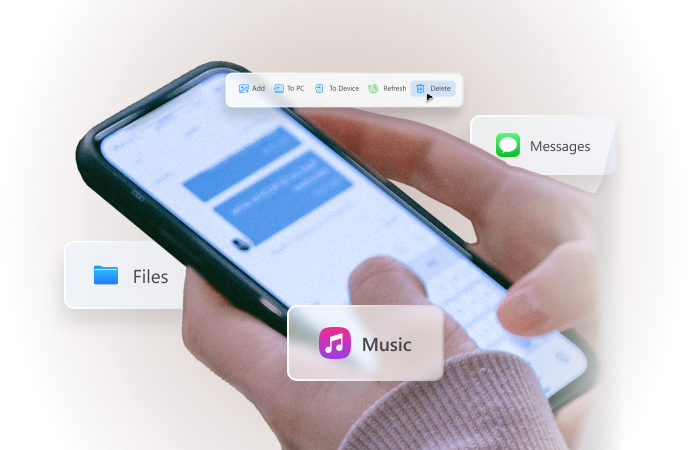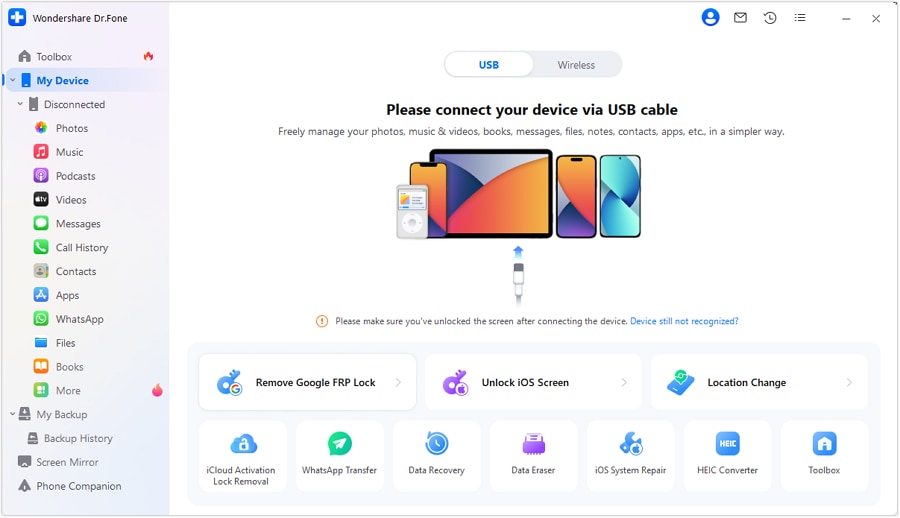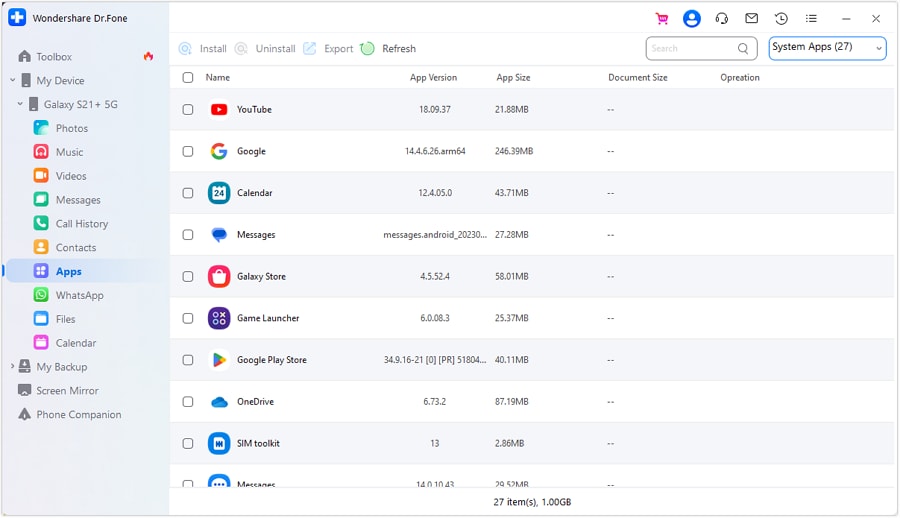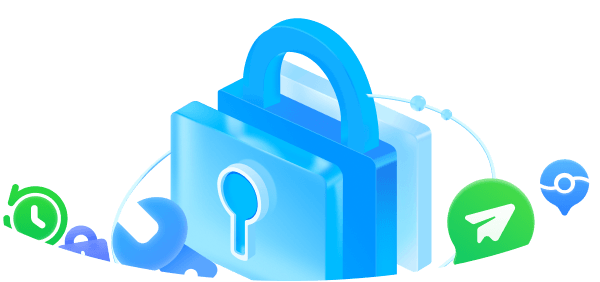
How to Uninstall Pre-installed Apps on Android & Samsung: 5 Easy Ways in 2025
Oct 24, 2025 • Filed to: Device Data Management • Proven solutions
Dr.Fone Basic:
Better Control for Your Phone
Manage, transfer, back up, restore, and mirror your device
Tired of unwanted apps cluttering up your new phone and eating up your storage? These apps, often called bloatware, can slow down your phone. If you're looking for how to delete preinstalled apps on your Android device, don't worry, you're in the right place. Removing them is a great way to free up valuable space and help your phone run faster.
This simple guide will show you exactly how to delete pre-installed Android apps. We'll cover easy methods to either disable them temporarily or remove them from your phone for good. By following our steps, you can easily clean up your device, get rid of annoying bloatware, and take back control of your phone's performance.

- Part 1: Delete Pre Installed Android Apps Using Settings
- Part 2: Delete Pre Installed Android Apps Using Google Play
- Part 3: Delete Pre Installed Android Apps By Disabling Bloatware
- Part 4: Delete Pre Installed Android Apps Using The App Drawer

- Part 5: The Ultimate Solution: Using Dr.Fone for Stubborn Apps
Part 1: Delete Pre Installed Android Apps Using Settings
When you first get your new Android phone, you'll notice it comes preloaded with apps - some from the manufacturer, some from your mobile carrier, and some from Google. While some of these preinstalled apps, also known as bloatware, can be useful, others just take up space and battery life. If you want to delete preinstalled apps on your Android device, you can do so right from the Settings app. Here's how to uninstall and remove unwanted apps that came on your phone or tablet.

Step 1: Navigate to Settings > Apps (this may also be labeled "Apps & notifications" or "Application Manager").
Step 2: Find the app you want to manage in the list and tap on it to open its information page.
Step 3: Choose your action:
- Tap Uninstall to remove the app completely.
- If "Uninstall" is not available, tap Disable to hide the app and prevent it from running.
- Use Force Stop to immediately close an app that is causing issues.
By uninstalling unwanted preloaded apps, you can free up storage space, speed up your Android, and increase battery life. It also gives you control over bloatware taking up space on your device. With these simple steps, you can customize your Android device, delete bloatware apps, and improve performance. Removing unnecessary pre-installed apps helps declutter your phone and tablet.
Part 2: Delete Pre Installed Android Apps Using Google Play
While a few pre-installed apps can be useful, you may want to remove unnecessary ones that take up space. Instead of using the Settings app, you can also uninstall apps directly through the Google Play Store.

Here are the steps to remove pre installed apps on Android using the Play Store:
Step 1: Navigate to Your Apps
Open the Google Play Store and tap your profile icon in the top-right corner. From the menu, select Manage apps & device.
Step 2: Select Apps for Removal
Switch to the Manage tab to see a complete list of your installed applications. Scroll to find the preinstalled app you want to remove and tap the checkbox next to its name. You can select multiple apps to uninstall them all at once.
Step 3: Uninstall and Confirm
With your app(s) selected, tap the trash can icon that appears at the top of the screen. A confirmation window will appear; tap Uninstall to finish the process and remove the apps from your device.
Following these steps allows you to take control of bloatware and preloaded apps. By uninstalling unnecessary apps, you can speed up your Android device and improve battery life. Removing unwanted preinstalled apps declutters your phone and maximizes storage.
Part 3: Delete Pre Installed Android Apps By Disabling Bloatware
Here is another option to remove preloaded apps from your Android device. First, try disabling unwanted apps instead of fully uninstalling them. Here's how:

Step 1: Open the Play Store and go to the app's page. Uninstall any updates to revert it to the original version.
Step 2: Now go to Settings > Apps & notifications and select the app.
Step 3: Tap Permissions and disable any permissions you don't want the app to have. This keeps it limited if you ever re-enable it.
Step 4: Finally, tap Disable. This will turn off the app so it can't run or use resources. Press OK to confirm.
Disabling pre-installed apps you don't use can improve performance without deleting them entirely. However, some apps may be tied to core phone functions. Note any warnings before disabling.
If you want to permanently remove bloatware, you can root your Android. Rooting gives you "superuser" access to delete system apps and install custom firmware.
Rooting is not for everyone. But if you're comfortable with the risks, it lets you take full control and delete otherwise irremovable apps.
By disabling or uninstalling preloaded bloatware you don't need, you can free up storage space and system resources. Your Android will run faster and improve battery life. Carefully weigh the options to reclaim your phone from unnecessary apps.
Part 4: Delete Pre Installed Android Apps Using The App Drawer

Follow these simple steps to delete those unwanted apps right from your app drawer:
Step 1: Locate the App in Your App Drawer
Open your app drawer, which you can typically access by swiping up from your home screen. Scroll through your applications to find the preinstalled app you want to delete.
Step 2: Initiate the Uninstall
Press and hold the app's icon until a small menu appears on the screen. From this menu, select the Uninstall option.
Step 3: Confirm the Deletion
A final prompt will ask you to confirm your choice. Tap OK or Uninstall to permanently remove the app from your Android device. The app icon will then disappear from your app drawer.
Following this easy process allows you to free up storage space and get rid of manufacturer or carrier apps you have no use for. Your Android phone will run faster without all that extra bloatware taking up resources.
However, not all pre-installed apps can be fully uninstalled this way. Some core apps are only able to be disabled. You'll know an app can't be deleted if you don't see the uninstall option.
With just a few taps, you can take control of your new phone and remove unwanted apps. Declutter your app drawer and customize your Android by following these steps to delete bloatware.
Part 5: The Ultimate Solution: Using Dr.Fone for Stubborn Apps
If the standard methods for removing preloaded apps don't work, you may need a more powerful tool. Wondershare Dr.Fone is an excellent program that gives you full control over the apps on your Android device. Here is a guide on how to use Dr.Fone to delete pre-installed apps on Android:

Dr.Fone - Phone Manager (Android)
One-Stop Solution to Manage and Transfer Data on Android Phone
- Transfer files between Android and computer, including contacts, photos, music, SMS, and more.
- Manage, export/import your music, photos, videos, contacts, SMS, Apps, etc.
- Transfer iTunes to Android (vice versa).
- Manage your Android device on the computer.
- Fully compatible with the newest Android OS.
Step 1: Connect and Launch the App Manager
First, download and install Dr.Fone for Android on your computer. Once installed, connect your Android device with a USB cable and allow the software to detect it. From the main Dr.Fone interface, navigate to Toolbox > App Manager.

Step 2: Select Pre-installed Apps for Removal
The App Manager will scan your device and display a complete list of all installed applications. Scroll through this list to find the pre-installed apps or bloatware you want to remove. Select each app by checking the box next to its name.
Step 3: Uninstall the Apps
After selecting all the apps you wish to delete, click the Uninstall button, typically located at the top of the window. Dr.Fone will then proceed to remove the selected apps from your Android system.

The key benefit of Dr.Fone is that it uninstalls system apps that other methods can't remove. With root access, Dr.Fone provides the ultimate solution for deleting stubborn preloaded apps.
So if you need to clean up your Android device deeply, Dr.Fone App Manager is a recommended tool. It allows you to easily take control and remove unwanted bloatware and free up valuable storage space on any Android device.
Conclusion
Getting a new Android phone often means dealing with pre-installed bloatware apps. While some manufacturer or carrier apps can be useful, many are unnecessary and take up space. Thankfully, you can uninstall or disable preloaded apps on your Android device. Using the Settings menu, Google Play Store, or apps like Dr.Fone, you can delete unwanted preinstalled apps. Removing bloatware improves performance, frees up storage, and increases battery life. With a few simple steps, you can take control of your Android phone and remove excess apps not needed. Learning how to uninstall preinstalled bloatware is a great way to optimize and customize your new phone to your liking.
FAQs
Dr.Fone Basic:
Better Control for Your Phone
Manage, transfer, back up, restore, and mirror your device
Android Erase
- Android Diagnostics
- 1. Fix Android Microphone Issues
- 2. Test NFC on Android Device
- 3. Check Android Device in Minutes
- 4. Apps For Sensor Check Android
- 5. Apps for Testing Device's Hardware
- 6. Tools for Conducting Screen Tests
- 7. Ways to Check Phone's Vibrations
- 8. Check Mobile Signal Strength
- 9.Realme Touch Screen Test Codes
- 10.Android Codes To Test Touch Screen
- 11.Phone Processor Speed Tests
- Erase Android
- 1. Delete Browsing History on Android
- 2. Clear App Data and Cache on Android
- 3. Delete Photos from Android
- 4. Wipe Android When It's Lost
- 5. Wipe Cache Partition on Android
- 6. Delete Text Messages on Android
- 7. Delete WhatsApp Backup
- 8. Wipe Data or Factory Reset
- 9. Erase Android Data Before Selling
- 10. Delete Contacts on Android
- 11.Delete Multiple Contacts on Android
- 12.Wipe Android Phone before Selling
- 13.Delete Photos on Android
- 14.Remove Pre-installed Apps
- 15.Delete Apps on Android
- 16. Access Trash on Android
- Android Reset
- 1. Restart Phone without Power Button
- 2. Reset Phone without Volume Buttons
- 3. Factory Reset Android Phone
- 4. Hard Reset Android Phone Using PC
- 5. Hard Reset Locked Infinix Phone
- 6. Factory Reset Lenovo Phone
- 7. Factory Reset Android Tablets
- 8. Factory Reset Lenovo Tablets
- 9. Format Your Android Phone
- 10. Hard Reset Android Phones
- 11.Reset Android Without Home Button
- 12.Restart Your Android Phone
- 13.Soft Reset Android Devices
- 14.Reset Android without Losing Data
- 15.Ways to Hard Reset Tecno Spark
- 16.Updated Android Factory Reset Code
- Data Erase Apps
- 1. Speed Booster for Android
- 2. Android Cleaners to Boost Device
- 3. Data Erase Apps to Protect Privacy
- 4. Data Eraser Apps to Wipe Android
- 5. 15 Best Cleaning Apps for Android
- Sell Old Android



















Daisy Raines
staff Editor